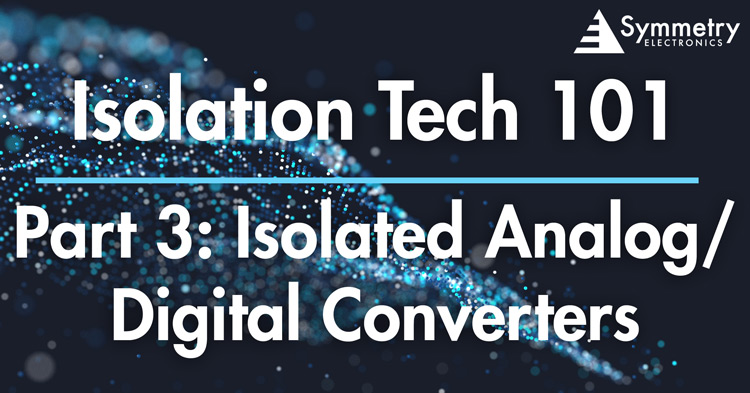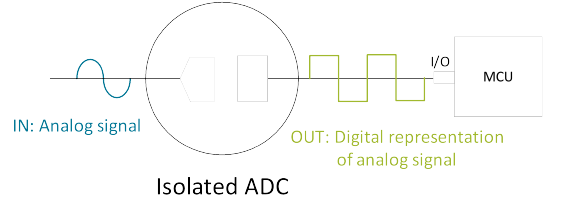- Home
- Symmetry Blog
- Part 3: Isolated Analog / Digital Converters
Isolation Tech 101, Part 3: Isolated Analog / Digital Converters | Symmetry Blog
About Symmetry Electronics
Established in 1998, Symmetry Electronics, a Division of Braemac, is a global distributor of electronic components and systems. Combining premier components and comprehensive value-added services with an expert in-house engineering team, Symmetry supports engineers in the design, development, and deployment of a broad range of connected technologies.
Exponential Technology Group Member
Acquired by Berkshire Hathaway company TTI, Inc. in 2017, Symmetry Electronics is a proud Exponential Technology Group (XTG) member. A collection of specialty semiconductor distributors and engineering design firms, XTG stands alongside industry leaders TTI Inc., Mouser Electronics, and Sager Electronics. Together, we provide a united global supply chain solution with the shared mission of simplifying engineering, offering affordable technologies, and assisting engineers in accelerating time to market. For more information about XTG, visit www.xponentialgroup.com.

Many considerations come into play when choosing the right isolator for your application. In a new blog series from Symmetry Electronics, we will be covering the different types of isolators available. In Part 1, we covered digital isolators and in Part 2, we covered isolated gate drivers. For Part 3, we will be providing an overview of Isolated Analog to Digital Converters, how they work, and when to use them.
Keep reading to learn everything you need to know about isolated analog/digital converters.
Isolated Analog to Digital Converters
In: Analog signal
Out: Digital representation of analog signal

Why use an isolated monitoring ADC?
AC line monitors measure the real-time quality of power delivered to a given load. These devices are diverse in capabilities, measurement accuracy and cost with systems ranging from simple, single-phase line fault detectors to high-precision multiphase systems that capture and log frequency, voltage and current perturbations, harmonic voltage amplitudes and voltage unbalance.
Several end applications are driving the growth of ac line monitor usage. For example, ever-expanding data processing centers monitor not only the power expended in data processing operation but also power usage in infrastructure equipment, such as heating and air conditioning, lighting, security and communications, with the goal of managing all aspects of operation at peak efficiency. Green energy systems are also gradually becoming another driver in photovoltaic (PV) inverters and other renewable energy resources. Even “hard hat” workers involved in construction and infrastructure projects are attaching ac power monitors to their portable generators to protect expensive equipment from being damaged by unstable line frequencies, electrical transients and other abnormalities. Add to these applications the long-time use of ac line monitors in medical facilities, research laboratories and industrial complexes. One thing is certain: If any aspect of line power is critical to a given application, it is almost guaranteed that an ac line monitor is at work keeping a sharp eye on electrons being pushed through conductors.
Selecting an ac line monitor for a given application is simple. The first step is for the developer to generate a target specification list that satisfies the end application. Beyond this step, the only other considerations are meeting galvanic isolation safety standards and evaluating the cost of the solution. System-level ac line monitors offer the advantages of flexibility, small size, high precision, high reliability, flexible connectivity and ease-of-use. For single or low-quantity monitoring applications, some users might develop their own ac line monitor using some combination of voltage and current transformers (and possibly Hall Effect current sensors) and connect the outputs to external volt meters or other instrumentation. While these approaches may be both adequate and expedient for monitoring simple “one-off” applications, their size and electromagnetic interference (EMI) often make scalability difficult for future expansion. In the end, these approaches cannot compete with the size, accuracy and robust feature set of system-level ac line monitors.
How does an isolated monitoring ADC work?
Regardless of complexity, most modern ac line monitors use one or more analog-to-digital converters (ADCs) to convert analog power line signals into a digital format, then crunch converted data using a local high-speed processor. This approach enables the line monitor to indirectly derive many useful operating parameters by direct calculation. Parameters, such as peak and average power output, power factor angle, harmonic voltage amplitude and line frequency, are often calculated by manipulating voltage and current data.
The developer’s selection of any given ac line monitor is determined by the needs of the end application. For example, utility power meters, which are at the heart of the billing process, can negatively impact the service provider’s profit or the customer’s pocketbook if the capabilities of the utility meter are less than adequate. For these types of precision applications, the line monitor must be designed for high accuracy and tamper-proof operation, and will most likely use separate ADCs (triggered simultaneously) to measure voltage and current and minimize voltage-current phase shift error as shown in Figure 2A. This line monitor would also use high-precision (e.g., 24-bit) ADCs to ensure that system noise performance is adequate to provide the required effective number of bits (ENOB) for rated measurement accuracy.
Contrast this requirement to a different application that only needs to detect gross line faults and measure load efficiency. Such a system would be substantially less sophisticated compared to the utility meter example, and would probably use a low-cost, single 10 to 12-bit low-cost ADC (see Figure 2B). The same is true of line monitors with integrated signal processing. The math overhead associated with a utility system would mandate a premium microcontroller (MCU) or digital signal processor (DSP), whereas the line fault monitor can implement its entire functionality within a small state machine or a single, low-cost commodity MCU.
What is AC Monitor Analog Front End (ACAFE)?
While sophisticated ac installations require highly precise and expensive line monitoring equipment, there is a large and diverse group of less sophisticated applications that effectively need only an ac monitor analog front end (ACAFE) capable of measuring, converting and transmitting data to external data processing devices. This ACAFE approach is flexible in that any processor having a UART, I2C or SPI port can directly command the ACAFE and receive the resulting converted data (see Figure 3). The ACAFE can connect to PCs and other computing systems by adding a protocol converter (e.g., I2C to USB converter) between the ACAFE and computing device.
The ACAFE is based on a single-chip, isolated smart ADC (in this example, the Si890x family from Silicon Labs) that contains an ADC subsystem with a 10-bit, 500 ksps SAR ADC preceded by a three-channel analog input multiplexer (MUX) and a series gain amplifier with user-programmable settings of 1x or 0.5x gain. The ADC has an internal reference, but it can also use an external reference if so desired. Other on- chip functions include a control state machine, which supervises all transactions between the host controller and the ACAFE; a UART, I2C or SPI serial port; and a 2.5 kV or 5.0 kV rated galvanic isolator that provides both input/output safety isolation and voltage level shifting. This highly integrated, single package ACAFE implementation simplifies designs and enables very good monitoring performance within an economical budget.
The ACAFE can operate in one of two user-selectable operating modes. In Demand Mode, the external host controller triggers a single ADC conversion on demand. This mode is helpful in cases where an ADC conversion must be performed at a specific time due to noise or system state. The ACAFE also can operate in Burst Mode, where ADC conversions are performed continuously. The system host processor can switch from one mode to the other as needed.
The UART and I2C serial ports operate in the range of 250 kbps, and the SPI port operates at up to 2.4 Mbps. These ports are isolated by a Silicon Labs CMOS isolator rated at the user’s choice of either 2.5 kV or 5 kV. A typical application circuit using the Si890x ACAFE, where the Si890x operates as a single-phase ac line voltage and current monitor. The user provides the line side interface circuit (differential amplifier and VDDA dc bias using a commodity op amp, LDO and passives). The ac current is measured on ADC input AIN0 while the ac line voltage is scaled by resistors R17 and R18 and level-shifted by the 1.5 V VREF. The ac line current is measured using the differential amplifier, U1, connected across the shunt resistor, R1. Data is transferred to the external controller or processor via the isolated serial port.
The turnkey ACAFE evaluation module makes it safe and easy to evaluate the ACAFE. This module contains a fully-implemented line-side interface with bias supply and can work with all three versions of the Si890x isolated ADCs – any one of which can be manually selected by the user for evaluation. The module also contains a host processor that can issue ADC conversion commands and receive data. The host processor has two integrated digital-to-analog converters (DACs) that can restore the digitally-formatted signals back to analog, enabling the user to view the reconstituted analog waveforms on an oscilloscope. Developers also can reprogram the flash-based host controller to suit their needs using a Silicon Labs development kit.
AC line monitors police the venerable ac line, keeping it honest and free from potentially damaging electrical events. These ac line monitors come in many shapes, sizes and feature sets, all of which must complement the application at hand. The ACAFE approach provides a flexible, small-footprint and cost- effective ac line monitoring solution that best serves ac line monitoring applications of moderate complexity.
Where do I find the best Isolated ADCs for my needs?
Silicon Labs has a single family to fit all needs, the Si890x
The Si8900/1/2 series of isolated monitoring ADCs are useful as linear signal galvanic isolators, level shifters, and/or ground loop eliminators in many applications including power-delivery systems and solar inverters. These devices integrate a 10-bit SAR ADC subsystem, supervisory state machine and isolated UART (Si8900), I2C/SMbus port (Si8901), or SPI Port (Si8902) in a single package. Based on Silicon Labs’ proprietary CMOS isolation technology, ordering options include a choice of 2.5 or 5 kV isolation ratings. All products are safety certified by UL, CSA, and VDE. The Si8900/1/2 devices offer a typical common-mode transient immunity performance of 45 kV/µs for robust performance in noisy and high-voltage environments. Devices in this family are available in 16-pin SOIC wide-body packages
Silicon Labs’ products provide the best performance and reliability
- Highest noise immunity
- Fastest data rates & lowest prop delays
- Failsafe data transmission
- Lowest EMI emissions
- Highest reliability
